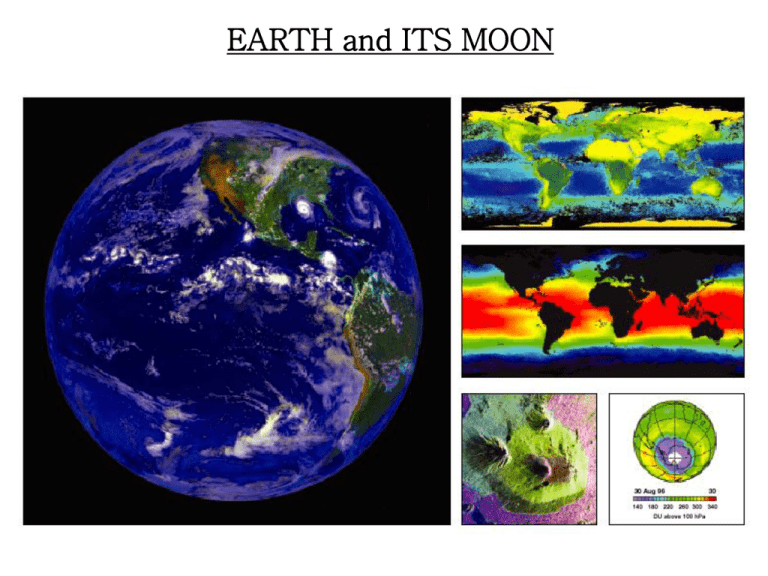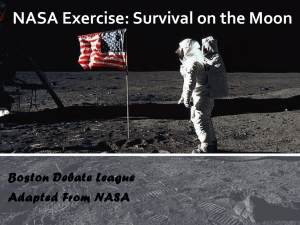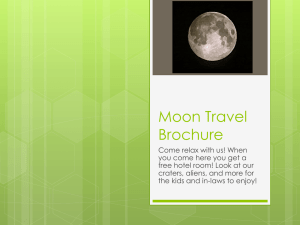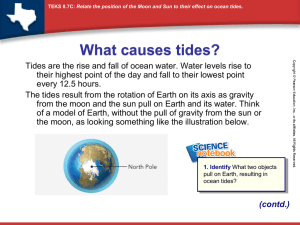Earth and Moon
advertisement

EARTH and ITS MOON Main Structure Our planet may be divided into six main regions. In Earth’s interior a thick mantle surrounds a smaller, two-part core. At the surface we have a relatively thin crust, comprising the solid continents and the seafloor; and the hydrosphere, comprising rivers, lakes, and the liquid oceans. An atmosphere of air lies just above the surface. At much greater altitudes a zone of charged particles trapped by our planet’s magnetic field forms Earth’s magnetosphere. The Moon lacks a hydrosphere, an atmosphere, and a magnetosphere. Its internal structure is not as well studied as that of Earth, for the very good reason that the Moon is much less accessible. Nevertheless, the same basic interior regions as found on Earth—crust, mantle, and core— may also be discerned on the Moon, although their properties differ somewhat from those of their Earthly counterparts. Earth and Moon The main regions of Earth and the Moon (not drawn to scale). (a) At Earth’s center is an inner core, with a radius of about 1300 km. Surrounding the inner core is a liquid outer core 3500 km in radius. Most of the rest of Earth’s 6400-km interior is taken up by the mantle, which is topped by a thin crust only a few tens of kilometers thick. The liquid portions of Earth’s surface make up the hydrosphere. Above the hydrosphere and solid crust lies the atmosphere, most of it within 50 km of the surface. Earth’s outermost region is the magnetosphere, extending thousands of kilometers into space. (b) The Moon’s rocky outer mantle is about 900 km thick. The inner mantle is a semisolid layer similar to the upper regions of Earth’s mantle. At the center lies the core, which may be partly molten. Tides • Both the moon and the sun cause tides in the earth’s oceans and even atmosphere. • But even though the gravitational pull on the Earth by the sun is much greater than that of the moon, the moon has a bigger tidal effect than the sun. As a matter of fact, the moon is almost entirely responsible for the familiar ocean tides. Why? Because gravity obeys an inverse-square relationship and the moon is much closer to the Earth than the sun. The Sun Makes Little Difference The DIFFERENCE in gravitational pull on one part of the Earth compared to another causes the tidal distortion, and the moon’s pull on the Earth varies more across the Earth than the sun’s pull. The sun is about 93 million miles away. The size of the Earth is very small compared to this. So the side of the Earth closest to the sun is about 93 million miles away, and the side of the Earth farthest from the sun is still about 93 million miles away. There is very little difference. The Moon Matters However, the moon is only about 239,000 miles from the Earth. Since the Earth is about 4000 miles in radius, then the side of the Earth closest to the moon is about 8000 miles closer than the side of the Earth farthest from the moon. This distance is significant – it is about 3.3% of the total distance. Since the difference is squared then when we consider gravity, this difference in even more significant. The difference in the moon’s gravitational pull varies by about 7% from the close side of the Earth to the far side of the Earth. Gravitational Force by Object A A Since planet is close to object A, there is a significant difference in gravtitational pull from one side to the other. Since planet is far from object A, there is little difference in gravtitational pull from one side to the other. Distance The ocean water nearest the moon is pulled harder than the ocean bottom beneath it, so the ocean swells up to produce a high tide. On the other side of the Earth, the ocean bottom is pulled toward the moon harder than the ocean, and so there is a simultaneous swell on this side. The Earth is stretched, and since water can flow, high tides result on the sides of the Earth closest and farthest from the moon, while the other sides of the Earth experience low tides. The low tides result because the water flows to the regions where there is a high tide. Low tide High tide F F F F Low tide Physlet: Tides High tide Spring Tides and Neap Tides When Earth, Moon, and Sun are roughly lined up — at new or full Moon — the gravitational effects reinforce one another, and the highest tides occur. These tides are known as spring tides. When the Earth–Moon line is perpendicular to the Earth –Sun line (at the first and third quarters), the daily tides are smallest. These are termed neap tides. Tidal Locking The Moon rotates once on its axis in 27.3 days—exactly the same time as it takes to complete one revolution around Earth. As a result, the Moon presents the same face toward Earth at all times; that is, the Moon has a “near” side, which is always visible from Earth, and a “far” side, which never is. This condition, in which the rotation period of a body is precisely equal to (or synchronized with) its orbital period around another body, is known as a synchronous orbit. Tidal Bulge: The tidal bulge raised in Earth by the Moon does not point directly at the Moon. Instead, because of the effects of friction, the bulge points slightly “ahead” of the Moon, in the direction of Earth’s rotation. (The magnitude of the effect is greatly exaggerated in this diagram.) Because the Moon’s gravitational pull on the nearside part of the bulge is greater than the pull on the far side, the overall effect is to decrease Earth’s rotation rate. According to fossil measurements, the rate of decrease is just two milliseconds every century—not much on the scale of a human lifetime, but it means that half a billion years ago Earth’s day was just over 21 hours long and its year contained 410 days. At the same time, the Moon spirals slowly away from Earth, increasing its average distance from our planet by about 4 cm per year. We have been able to accurately measure this by bouncing lasers off of reflectors left on the moon by the astronauts. This process will continue until (billions of years from now) Earth rotates on its axis at exactly the same rate as the Moon orbits Earth—that is, Earth’s rotation will become synchronized with the Moon’s motion. At that time the Moon will always be above the same point on Earth and will no longer lag behind the bulge it raises. The Moon’s orbit became synchronous long ago—the Moon is said to have become tidally locked to Earth. Most of the moons in the solar system are similarly locked by the tidal forces of their parent planets. Earth's Atmosphere Compared with Earth’s overall dimensions, the extent of the atmosphere is not great. Half of it lies within 5 km of the surface, and all but 1 percent of it is found below 30 km. QUESTION Why is there virtually no atmosphere on the moon while the Earth has an abundant atmosphere? Discuss this with your neighbors for a few minutes. The Earth’s Magnetic Field (Dynamo Model) Magnetic field of Earth is shaped like there’s a giant bar-magnet located inside the Earth’s core. • Tilts at 12o from the spin axis. N • All magnets have two poles - a north pole and a south pole. S • Magnetic fields (B) come from electrical charges in motion (currents). N S current B B current A current through a slinky shaped wire (i.e. solenoid) will produce a strong magnetic field inside the solenoid. Outside the solenoid the field looks like it does for a bar magnet. The Earth’s B-field apparently just suddenly flip-flops every so often (i.e. it reverses); It has happened 9 times in past 3.5 million years – more often in earlier years. What causes this is unknown. Earth’s B-field appears to be created by the dynamo model via the hot fluid conducting metals in core which contain charges that will flow in circles from convection (heating and cooling) and the Earth’s rotation The magnetic field of the Earth helps protect us from dangerous space radiation (i.e. cosmic rays) which are high speed charges. Some charges get trapped in our B-field and spiral around (in a helix shape) B-field lines. • Many of the charges are protons and electrons that came streaming off the Sun (called the Solar Wind). • The two donut shaped areas around the Earth where these charges are trapped are called the Van Allen radiation belts. • The charges spiral with high energy into the Earth’s magnetic poles and when they hit the atmosphere which excite the atoms in the atmosphere and cause it to glow (called an aurora – the Aurora Borealis near the north magnetic pole is often called "The Northern Lights"). Mantle Outer core Convection Inner core Rotation The fluid currents in the core are driven by the overall non-uniform rotation, where the inner parts rotate at a higher angular speed than the outer parts, combined with the convection in small regions. These organized currents, in turn, are believed to generate the earth’s magnetic field. Mantle Outer core Convection Inner core Rotation Exercise: Assuming the direction of the arrows above represent the direction the conventional electric current, draw arrows in the appropriate direction on the magnetic field lines in the diagram above. The Northern Lights Charged particles from outer space that move at nearly the speed of light are usually called "cosmic rays". These cosmic rays rain down on the Earth at a fairly steady rate. However, we are not harmed by this radiation because the Earth's magnetic field shields us. The Earth has a magnetic field around it. The source of the magnetic field is deep within the Earth. We can understand it by imagining a large bar magnet inside the Earth. All magnets have a north pole and a south pole. The magnetic field points out of the magnetic north pole and into the magnetic south pole. The magnetic south pole of the Earth is close to (but not perfectly aligned with) the geographic north pole of the Earth. The magnetic north pole of the Earth is close to (but not perfectly aligned with) the geographic south pole. Most people don't realize this and sometimes maps will even refer to the magnetic pole in northern Canada as "magnetic north". Charged particles tend to follow a helical path around the magnetic field lines when they move through a magnetic field. The stronger the magnetic field, the tighter (smaller) the helical path is. The magnetic field of the Earth is strongest near the poles. So the charged cosmic rays heading for the Earth get caught in our magnetic field and then are "funneled" toward the poles of the Earth. As the charged particles get closer to the Earth they enter our atmosphere and have collisions with air molecules. The air molecules excite from the collisions and then de-excite and give off photons (light). The result is what we call the aurora borealis, or northern lights. There is also an equivalent phenomenon in the southern hemisphere called the aurora australis, or southern lights. "Nature" can be so very beautiful, can't it? Two interesting things to ponder: • If we lived near the magnetic poles of the Earth, we would receive a larger amount of damaging space radiation than living in the mid-latitudes of the Earth. Why don't we live near the north and south poles of the Earth? Because it is too cold for us. So we naturally choose the mid-latitude environments to live in, which ends up being safer for us. • The magnetic field of the Earth reverses (I.e. the poles flip-flop the magnetic north pole becomes magnetic south pole, and vice versa) every 10,000 years or so. We do not know how or why at this point. The Greenhouse Effect Long-wavelength infrared radiation is partially blocked by Earth’s atmosphere, mainly because of carbon dioxide and water vapor, both of which absorb very efficiently in the infrared portion of the spectrum. Even though these two gases are only trace constituents of our atmosphere, they manage to absorb a large fraction of all the infrared radiation emitted from the surface. Consequently, only some of that radiation escapes back into space. The rest is radiated back to the surface, causing the temperature to rise. This partial trapping of solar radiation is known as the greenhouse effect. The name comes about because a similar process operates in a greenhouse — sunlight passes relatively unhindered through glass panes, but much of the infrared radiation reemitted by the plants is blocked by the glass and cannot get out. Carbon dioxide is of particular concern today, because its concentration in Earth’s atmosphere is increasing, largely as a result of the burning of fossil fuels (principally oil and coal) in the industrialized world. Carbon dioxide levels have increased by more than 20 percent in the last century, and they continue to rise at a present rate of four percent per decade. Many scientists believe that this increase, if left unchecked, may result in global temperature increases of several Kelvins over the next halfcentury, enough to melt much of the polar ice caps and cause dramatic, perhaps even catastrophic, changes in Earth’s climate. The Earth's Moon The moon has dark areas called maria (Latin - “seas"; singular form mare) • • • • • • • Discovered by Galileo Most appear on “northern” half of the moon on the side facing the earth Most look circular (or approximately circular) Lower elevations (by 3 km than rest of the surface) – called "lowlands" Formed of solidified lava flows Cover about 20% of moon’s surface Features called mascons (heavy dense concentrations of mass) are beneath most of the maria – the formation of mascons is not understood at this time. The moon has craters (Greek for “cup” or “bowl”) • Round depressions scattered over most of the moon’s surface • Range widely in size (from smaller than a pinhead to 200 km in diameter • Formed by impact of solid objects (meteoroids) from space that slam into the moon (Often the rock undergoes "fluid motion" initially after collision often leaving a “bump” in the middle of the crater and “waves” out at rim) • Small craters outnumber larger craters Apollo Mission Results Surface of Moon is 1 - 20 meters deep made up of fine particles and larger rocks mixed with (mostly round) pieces of glass (a millimeter or so in diameter) formed by heat of collision from collision explosions – “slippery” ) Rocks • • • • Mare Basalts (magnesium - iron silicates) Anorthosites (aluminum - calcium silicates) Breccias (rock and mineral fragments bound together) In general, Moon rocks contain more titanium, uranium, iron, and magnesium than earth rocks The geology implies that Moon was formed about 4.6 billion years ago • Highlands solidified about 4 billion years ago • Lava flows that made maria took place about 3 billion years ago The interior structure of the Moon can be inferred from Apollo seismic and heat flow measurements. • There is a relatively large core of iron-rich silicates, a rocky mantle, and a relatively thick crust. • Metals make up a small percentage of the total composition. • Core (500 km radius) may be molten (about 1500 K) • Core is not entirely liquid metal since magnetic field of the Moon is very weak – only about 1/10,000 as strong as the Earth's magnetic field 2900 kg/m3 Density 3500 kg/m3 Iron rich core moonquake zone iron poor mantle crust to Earth Origin of Moon Binary Accretion Model: The Earth and the moon formed together from same space dust. Support For Oxygen isotopic concentration same for Earth and moon Argument Against Moon has no water or dense iron core Giant Impact Model: Glancing collisions of Mars-sized object off young Earth vaporized debris from both objects thrown into orbit around Earth and Moon accreted from this. Support For Similarities in moon and Earth compositions (oxygen isotopic abundances) due to Earth contribution, differences due to contribution by colliding Volatiles (like water) would have escaped into space explaining the absence of it on moon. Angular momentum of the moon accounted for by a glancing blow at about 10 km/s. Tidal forces from Earth would inhibit the accretion of masses if within Roche limit (25 times a parent planet's radius). Moon is presently about 10 times further than this limit. Evolution of the Moon EVENT Formation TIME (billions of years ago) 4.6 PROCESSES Accretion of small chunks of material Melted shell 4.6 - 4.4 Melting of outer layer by heat from infall of material and/or radioactive decay ; volatile elements lost Cratered highlands 4.4 - 4.1 Solidification of crust while debris still falls in to crater it Large basins 4.1 - 3.9 Reduced infall, formation of basins by impact of a few large pieces ; outflow of more basalts from lava below solid crust Maria flooding 3.9 - 3.0 Flooding of basins by lava produced by radioactive decay Quiet crust 3.0 – present Bombardment by small particles to pulverize and erode surface









